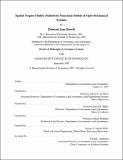Spatial Nyquist fidelity method for structural models of opto-mechanical systems
Author(s)
Howell, Deborah Jane, 1979-
DownloadFull printable version (13.08Mb)
Other Contributors
Massachusetts Institute of Technology. Dept. of Aeronautics and Astronautics.
Advisor
Olivier L. de Weck and David W. Miller.
Terms of use
Metadata
Show full item recordAbstract
As technology employed in complex multidisciplinary systems such as high performance telescope systems becomes ever more sophisticated, simulation is becoming more important during the initial design phases. The method of building these simulation models is often based on engineering experience with older, potentially dissimilar systems. A method is needed to measure the fidelity of simulation models so early design decisions are made based on appropriate modeling techniques. Previously, fidelity was a qualitative concept used to indicate a model's validity or accuracy. Here it is defined as the ability of a model to accurately predict chosen output figures of merit. In this thesis, a quantitative measure of fidelity, termed the Nyquist fidelity metric, is defined for commonly used structural model components. It expresses the ability of a finite element model to accurately predict structural eigenvalues based on the mesh size required by the spatial Nyquist criterion. The Nyquist fidelity method is developed which uses the fidelity metric to both assess the fidelity of existing complex models and to synthesize new multi-component models starting from architectural considerations such as geometric and material properties of the system. This method also estimates the error bound on the output figures of merit based on the fidelity levels and sensitivity analysis. The Nyquist fidelity method is applied to simple sample problems to first demonstrate the methodology and it is then applied to complex telescope models to show the accuracy and computational benefits of this method compared to current methods such as model reduction. The three high performance telescope case studies are the Modular Optical Space Telescope (MOST), the Thirty Meter Telescope, and the Stratospheric Observatory for Infrared Astronomy. (cont.) It is shown in the MOST example that the Nyquist fidelity method provides a 40% improvement in computational time while assuring less than 5% modal frequency error, and less than 2.2% error in the output figure of merit.
Description
Thesis (Ph. D.)--Massachusetts Institute of Technology, Dept. of Aeronautics and Astronautics, 2007. This electronic version was submitted by the student author. The certified thesis is available in the Institute Archives and Special Collections. Includes bibliographical references (p. 189-196).
Date issued
2007Department
Massachusetts Institute of Technology. Department of Aeronautics and AstronauticsPublisher
Massachusetts Institute of Technology
Keywords
Aeronautics and Astronautics.